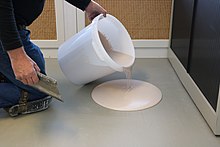
Back مشمع Arabic Лінолеум Byelorussian Балатум Bulgarian Linòleum Catalan Linoleum Czech Linoleum Danish Linoleum German Linoleumo Esperanto Linóleo Spanish Linoleum Estonian


Linoleum is a floor covering made from materials such as solidified linseed oil (linoxyn), pine resin, ground cork dust, sawdust, and mineral fillers such as calcium carbonate, most commonly on a burlap or canvas backing. Pigments are often added to the materials to create the desired color finish. Commercially, the material has been largely replaced by sheet vinyl flooring, although in the UK and Australia this is often still referred to as "lino".[1]
The finest linoleum floors, known as "inlaid", are extremely durable, and are made by joining and inlaying solid pieces of linoleum. Cheaper patterned linoleum comes in different grades or gauges, and is printed with thinner layers which are more prone to wear and tear. High-quality linoleum is flexible and thus can be used in buildings where a more rigid material (such as ceramic tile) would crack.